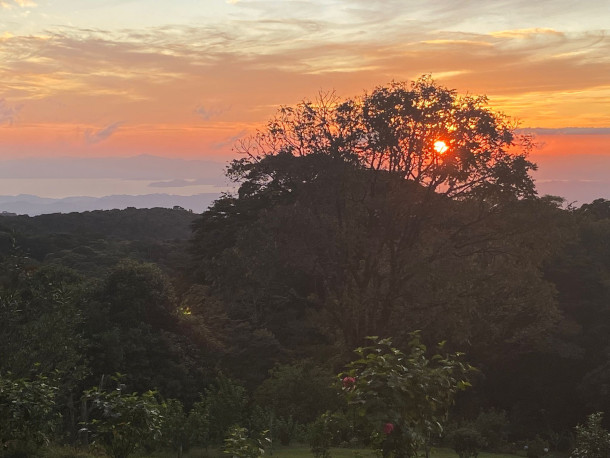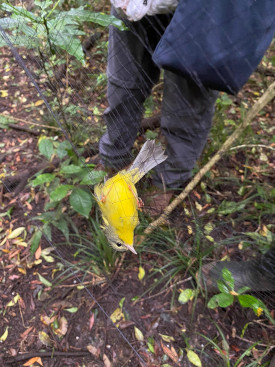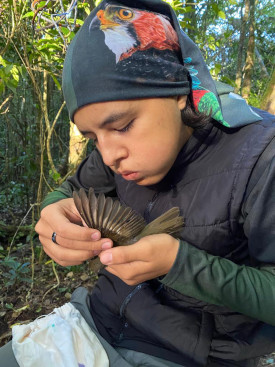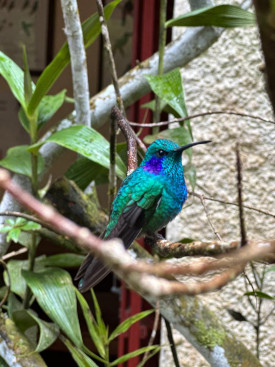Cloud Forest Bird Count
Air Date: Week of December 16, 2022

Costa Rica’s cloud forest is home to a large variety of birds – both migrant and resident. (Photo: Bobby Bascomb)
Cloud forest ecosystems are becoming warmer and drier with the climate crisis. So, each fall researchers in the cloud forest of Monteverde, Costa Rica conduct a bird census to see what migrant and resident birds are using the forest and how that’s changing with time. Host Bobby Bascomb reports.
Transcript
CURWOOD: It’s Living on Earth, I’m Steve Curwood
BASCOMB: And I’m Bobby Bascomb
So, Steve, I know you are a bit of a birder, right?
CURWOOD: Yeah, I often say I’m a recovering birder after all those early weekend mornings of being dragged outdoors by my mom as a kid but full confession I have pair of good binoculars now. And my Merlin app from Cornell is fully updated. It can id birds by sound.
BASCOMB: Ahh, I need to get that. Well, this time of year the birding in the North gets a lot simpler as migratory birds have flown south by now.
CURWOOD: Yes, but I still love to look for the tit mice, the cardinals and the bald eagles.
BASCOMB: You are looking for cardinals in the North but I’m in Costa Rica and keeping an eye out for birds coming down here. I think for a lot of us when certain birds leave the North they’re sort of out of sight out of mind but I’m seeing many species who had to fly thousands of miles to get to the warmer weather here.
CURWOOD: Oh, yeah, it’s just amazing what big distances tiny birds can fly.
BASCOMB: So, I’m here at one stop on the migration path for some birds, the cloud forest in Monteverde, Costa Rica.
CURWOOD: Cloud forests Bobby?
BASCOMB: Yeah, cloud forests are strictly found in tropical mountains where the conditions are just right to deliver a lot of rain and fog for much of the year and they’re among the most biodiverse ecosystems in the world. The forest in Monteverde is a mecca for migratory birds including hummingbirds which come in a dazzling array of colors as their names indicate. There’s the coppery headed emerald, magenta throated woodstar, and the green breasted mango. And flying so far to escape the cold and find food is an amazing endeavor for a bird no longer than your index finger and about the weight of a coin.
CURWOOD: Wow, that is so incredible.
BASCOMB: Yeah, and so each fall researchers in Monteverde check up on these birds. They use fine mist nets to catch some of them as they fly through the forest, including those tiny hummingbirds. So, one morning I tagged along to see what they’re learning.
[WALKING SOUNDS]
BASCOMB: It’s a chilly overcast morning with a fine misty rain hanging in the air. Ficus vines, covered in moss, twist together to form massive trees that dot the wide path I walk through in the forest. In the middle of the trail I soon see several researchers sit around a red plastic table topped with all the tools they will need for a day of field work. They’ve been at it since dawn. By the time I arrive around 8:00 they are collecting information on an unhappy white throated thrush. A medium sized dark gray bird with a white belly.
[BIRD SQUAWK]
BASCOMB: Diego Rodriguez is a local guide and biologist in training, he in intensely focused on his work as he holds the bird and examines it to determine age.

A golden crowned warbler is gently caught in the mist net. (Photo: Bobby Bascomb)
DIEGO: I think it's an adult. But I will check it out.
BASCOMB: Diego firmly holds the body of the bird in the palm of his hand and gently blows a patch of feathers backwards to get a look at the molt limit of the bird.
[BLOWING SOUNDS]
BASCOMB: That’s the spot between a set of feathers grown in different years.
[BLOWING SOUNDS]
LUISA: They change the feathers once a year in the tropics and sometimes you can tell the difference between the feathers from last year to the new year and that is called the molt limit.
BASCOMB: Luisa Moreno is the research coordinator with the Monteverde Institute and Diego’s mentor for this work.
LUISA: When you have a bird born this year they have a different pattern in the feathers like dots or buffy tips or something like that. And then you can tell the difference if that bird was born this year or it’s a second year or a third year. Depending on the species also.
BASCOMB: Diego collects data on gender, weight, and length and Luisa writes it down on a spreadsheet held fast on a clip board. They do this data collection twice a year, now when migrating birds have arrived and again in March before they head north.
[BIRD SQUAWK]
BASCOMB: They look at the overall health and condition of the birds. The absence of feathers on the chest and belly is called a brood patch and would suggests that birds are breeding here.
DIEGO: That looks like a very healthy bird, full grown. Zero zero zero, dos.

Diego Rodriguez blows on the bird’s feathers to look for the molt limit. (Photo: Bobby Bascomb)
BASCOMB: Diego places a small metal band on the bird’s leg and tells Luisa the number on the tag to write down. He then takes a last look at the bird and opens his palm to release it. It bites the skin between his thumb and index finger then takes off into the woods.
[beating wings and distant squawk]
BASCOMB: that couldn't have felt too good. It looked like a very sharp beak biting your hand.
DIEGO: That's not a very sharp one.
BASCOMB: No?
DIEGO: There are ones that have a sharper one. Yeah.
BASCOMB: We are at about 4500 feet of elevation, a key transitional area before the trees further up the mountain get smaller and become even more covered in moss and other epiphytic plants. Below us the forest is much warmer and drier. Luisa says they want to learn what migratory and resident species are using this forest.
LOUISA: Another thing we want to see if we if we capture a new species, because with climate change, species are moving higher. And we have found like three or four, like you can tell that they are changing in the past 20 years.
BASCOMB: So you're seeing birds here now that you didn't used to see, because of climate change, you think?
LOUISA: Yeah, like the white breasted wood wren, it's one species that you usually in the past, you can’t find here, and now you can find it.
BASCOMB: In the coming decades cloud forests are expected to become warmer and drier with climate change. That will dramatically change this ecosystem and the birds that can make their home here.

Living on Earth’s Bobby Bascomb warms the purple throated mountain gem hummingbird before release. (Photo: Bobby Bascomb)
LOUISA: We need to understand what is happening and how birds are dealing, any animal in general are dealing with that, and even the plants. I think one way what we can fight climate change is restoring some critical areas.
BASCOMB: As the climate is warming bird species that prefer cool weather are moving higher up the mountain, putting them in competition with birds that usually live here and are stressed with the warming as well.
LUISA: And the species here are not doing that well, that they used to.
BASCOMB: Those birds can move, of course, but they can only go so high up in search of cooler weather before they run out of mountain, forcing them to expend energy looking for another more suitable habitat on another mountain top.
[BIRD SOUND]
BASCOMB: Two other researchers emerge from the woods down the trail a bit and wave for Diego for him to join them.
Do they have a bird down there?
DIEGO: Maybe
BASCOMB: Can we go look?
DIEGO: Let’s see, maybe they have a bird yeah.
[SFX WALKING SOUNDS]
BASCOMB: We walk down the muddy path a bit and turn into the woods at the edge of the mist net they’ve set up. That’s a fine mesh black net strung between two poles about 40 feet apart. It stretches from knee high to about 9 feet up. Birds flying in the understory of the forest can get caught in the net.
[BLACK AND WHITE WARBLER]
BASCOMB: They’ve caught 2 golden crown warblers and a black and white warbler which Diego holds in one hand while trying to untangle the net from the bird’s tiny delicate feet with his other.
DIEGO: This is like the most risk point for birds in the nest because if they get tangled up. You really need to practice this because otherwise you can really hurt the bird.
BASCOMB: How often do they get injured in the process?
DIEGO: If you do a good job it should never happen. This one is almost out.
BASCOMB: Once freed from the net Diego places the bird in a small cotton bag with a draw string top to keep it safe and warm.
[SFX WALKING SOUNDS]
BASCOMB: Back at their red plastic table in the woods Diego uses a clothes pin to hang the bag on a line strung between two trees. 5 other birds in bags, collected by other members of the team, hang alongside it. Diego takes the first bag in the line and pulls out the tiniest bird so far.

A green violetear hummingbird perches on a nearby tree branch. (Photo: Bobby Bascomb)
BASCOMB: Is this a hummingbird?
DIEGO: Yup.
BASCOMB: What kind?
DIEGO: This one, it’s a purple throated mountain gem, a female.
BASCOMB: Diego collects most of his data and then puts the bird in a small cylinder on a digital scale to weigh it.
DIEGO: cuatro punto cuatro
BASCOMB: It’s 4.4 grams that’s .15 ounces less than the weight of a nickel. Hummingbirds are too small for leg bands so Diego snips a bit of the tail feather. That way if they catch this bird again he won’t record the same information twice. Then the tiny bird is ready to go. Diego opens his hand but it doesn’t move. He passes it to Luisa who cups here hands together and holds the tiny bird to help warm it.
LUISA: The weather is too cold now and also because it was in the net. So they waste a lot of energy fighting there.
LOUISA: Want to hold it?
BASCOMB: Yeah, is that ok? Oh!
LUISA: You can feel the heartbeat.
BASCOMB: Yeah, you can feel it vibrating. That’s the heart beat?
LUISA: No, just because it’s cold.
BASCOMB: While I do my best to warm the bird, Louisa speaks softly and offers it some food.
LUISA: This is sugar and water. The same thing that you have in the feeders. Just to get some energy.
BASCOMB: Is it drinking?
LUISA: No.
BASCOMB: I pass the tiny unmoving bird to another researcher. He must have warmer hands than mine because in less than a minute the hummingbird takes off in a flurry of iridescent wings.
[HUMMING BIRD]
BASCOMB: Satisfied, Luisa turns to the next bird.
Along with the purple throated mountain gem Luisa and her team catch and release 37 birds of 16 different species today, information will be added to the data set researchers have been collecting here since 2014.
LUISA: I love to do this! I love to be in the forest, I really enjoy showing people how to do this, why this is important so yeah I really look forward to do this every year.
BASCOMB: Luisa and Diego, get to hold hummingbirds and occasionally get bitten and they’re also making key contributions to how the cloud forest is changing with the climate crisis.
[BIRD SOUNDS]
Links
Living on Earth wants to hear from you!
Living on Earth
62 Calef Highway, Suite 212
Lee, NH 03861
Telephone: 617-287-4121
E-mail: comments@loe.org
Newsletter [Click here]
Donate to Living on Earth!
Living on Earth is an independent media program and relies entirely on contributions from listeners and institutions supporting public service. Please donate now to preserve an independent environmental voice.
NewsletterLiving on Earth offers a weekly delivery of the show's rundown to your mailbox. Sign up for our newsletter today!
 Sailors For The Sea: Be the change you want to sea.
Sailors For The Sea: Be the change you want to sea.
 The Grantham Foundation for the Protection of the Environment: Committed to protecting and improving the health of the global environment.
The Grantham Foundation for the Protection of the Environment: Committed to protecting and improving the health of the global environment.
 Contribute to Living on Earth and receive, as our gift to you, an archival print of one of Mark Seth Lender's extraordinary wildlife photographs. Follow the link to see Mark's current collection of photographs.
Contribute to Living on Earth and receive, as our gift to you, an archival print of one of Mark Seth Lender's extraordinary wildlife photographs. Follow the link to see Mark's current collection of photographs.
 Buy a signed copy of Mark Seth Lender's book Smeagull the Seagull & support Living on Earth
Buy a signed copy of Mark Seth Lender's book Smeagull the Seagull & support Living on Earth

